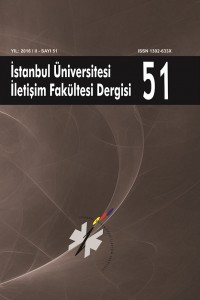Öz
This work examines the story of Dr. Jekyll and Mr. Hyde through an analysis of the film of Rouben Mamoulian’s, Dr. Jekyll and Mr. Hyde (1937). The main theme of the film is Jekyll’s creation of a new character, Hyde, from himself. This theme raises a philosophical question regarding the battle between good and evil. Mamoulian associates the character of Hyde with the metaphor of the primitive man; he explores the potential of evil in man as a consequence of the repression of his primitive needs. Mamoulian’s interpretation points to a conflict between the spiritual and material aspects of man. As such, it presents a perspective which can be interpreted by different disciplines. In this regard, this work examines the context which produces and supports both the film and Mamoulian’s theme. It examines how this context shapes the characters. Further, this context is explored as a possible means of reading the film through Sufism and psychoanalysis. In Sufism it is the nafs, when it is not properly tamed, which represents the dark and material aspect of the human. In this respect, this work first investigates the relationship of the nafs with the character Hyde, and the nature of the conflict created by the nafs. Following this, the work outlines Carl Jung’s definition for the potential of evil in psychoanalytic theory and explores the conflict of Jekyll/Hyde by considering the shadow archetype of Jung.
Anahtar Kelimeler
Kaynakça
- Aksöz, T. (2015). İnsan Benliğinin Arınması. Sakarya Üniversitesi İlahiyat Fakültesi Dergisi, 17(31),
- Alsford, M. (2006). Heroes and Villains. London ve Texas: Baylor University Press.
- Aşkar, M. (1998). TC Kültür Bakanlığı Kültür Eserleri. Ankara: TC Kültür Bakanlığı Yayınları.
Öz
Bu çalışmada, Dr. Jekyll ve Mr. Hyde öyküsü, Rouben Mamoulian’ın 1937 yapımı Dr. Jekyll ve Mr. Hyde filmi üzerinden tartışmaya açılacaktır. Jekyll’ın kendi içinden Hyde olarak yeni bir karakter oluşturması, filmin ana fikridir ve bu fikir insanın içindeki iyilik ve kötülük çatışmasını görünür kılan felsefi bir meseleye işaret etmektedir. Mamoulian, filmde Hyde karakterini aynı zamanda ilkel insan metaforu ile birleştirmekte ve insanın içindeki kötülük potansiyelini, insanın ilkel ihtiyaçlarının bastırılmasının sonuçları üzerinden izleyici ile paylaşmaktadır. Mamoulian’ın bu yorumu insanın manevi yönü ile beşer yönü arasındaki çatışmaya işaret etmektedir ve farklı disiplinlerin ışığı altında yorumlanabilecek bir bakış açısı sunmaktadır. Bu açıdan bu çalışmada, öncelikli olarak filmi oluşturan ve Mamoulian’ın ortaya koymaya çalıştığı fikri destekleyen düşünsel arka plan ve bu arka planın karakterleri nasıl şekillendirdiği ele alınmıştır. Ardından bu düşünsel arka planın sınırları genişletilerek filmin tasavvuf ve psikanaliz açısından okunmasının imkânı araştırılmıştır. Bu açıdan öncelikli olarak tasavvuf açısından, terbiye edilmediği sürece insanın karanlık ve beşeri yönünü temsil eden nefsin, Hyde karakteri ile ilişkisi ve nefsin insanda nasıl bir çatışmaya yol açtığı sorgulanmıştır. Sonraki bölümde insandaki kötülük potansiyelinin Carl Jung tarafından psikanalitik teoride nasıl tanımlandığı ortaya konmuş ve Jekyll/Hyde sunduğu çatışma bu kez Jung’un gölge arketipi açısından incelenmiştir.
Abstract
This work examines the story of Dr. Jekyll and Mr. Hyde through an analysis of the film of Rouben Mamoulian’s, Dr. Jekyll and Mr. Hyde (1937). The main theme of the film is Jekyll’s creation of a new character, Hyde, from himself. This theme raises a philosophical question regarding the battle between good and evil. Mamoulian associates the character of Hyde with the metaphor of the primitive man; he explores the potential of evil in man as a consequence of the repression of his primitive needs. Mamoulian’s interpretation points to a conflict between the spiritual and material aspects of man. As such, it presents a perspective which can be interpreted by different disciplines. In this regard, this work examines the context which produces and supports both the film and Mamoulian’s theme. It examines how this context shapes the characters. Further, this context is explored as a possible means of reading the film through Sufism and psychoanalysis. In Sufism it is the nafs, when it is not properly tamed, which represents the dark and material aspect of the human. In this respect, this work first investigates the relationship of the nafs with the character Hyde, and the nature of the conflict created by the nafs. Following this, the work outlines Carl Jung’s definition for the potential of evil in psychoanalytic theory and explores the conflict of Jekyll/Hyde by considering the shadow archetype of Jung.
Keywords: Nafs, Shadow Archetype, Cinema
Anahtar Kelimeler
Kaynakça
- Aksöz, T. (2015). İnsan Benliğinin Arınması. Sakarya Üniversitesi İlahiyat Fakültesi Dergisi, 17(31),
- Alsford, M. (2006). Heroes and Villains. London ve Texas: Baylor University Press.
- Aşkar, M. (1998). TC Kültür Bakanlığı Kültür Eserleri. Ankara: TC Kültür Bakanlığı Yayınları.
Ayrıntılar
| Birincil Dil | Türkçe |
|---|---|
| Bölüm | Makaleler |
| Yazarlar | |
| Yayımlanma Tarihi | 27 Aralık 2016 |
| Yayımlandığı Sayı | Yıl 2016 Sayı: 51 |


